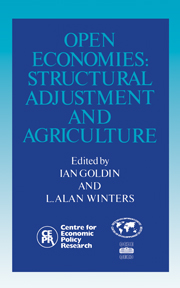Book contents
1 - Introduction: from macro to maize
Published online by Cambridge University Press: 04 August 2010
Summary
Introduction
All economies are open. Until recently, however, macroeconomic analysis for development has tended to build from a national rather than an international perspective. Economic analysis has made great strides, and a considerable body of literature is emerging around ‘open macroeconomies’. Despite this work, external policy assistance – and not least that associated with structural adjustment – is for the most part insular. The international dimension to structural adjustment has remained a neglected subject of policy analysis.
The relative neglect of the international dimension to structural adjustment is puzzling given the international origins of these policies: namely the 1970s’ successive oil price shocks and associated debt accumulation, compounded in the 1980s by high world interest rates, slackening demand and declining commodity prices. ‘Openness’ became a key consideration as developing countries became more aware of their vulnerability to external developments. Growing external and internal imbalances were compounded by tightening capital markets; starved of private capital and faced by growing disequilibrium, developing countries turned to the multilateral institutions for assistance, which increasingly was offered only on the basis of structural adjustment conditionality.
Adjustment is intrinsic to economic development. Urbanisation, the decline in agriculture's share in economic activity and other structural changes are regarded as indicative of development. ‘Structural adjustment’, however, refers to the restoration of equilibrium, providing a firmer foundation to withstand further shocks and facilitate development. In the current context, it denotes the set of policies associated most closely with World Bank and International Monetary Fund (IMF) external assistance to developing countries, and which have become conditions for receiving such assistance. Indeed, cross-conditionality, which links reform to other multilateral and bilateral assistance, is now being added.
- Type
- Chapter
- Information
- Open EconomiesStructural Adjustment and Agriculture, pp. 1 - 12Publisher: Cambridge University PressPrint publication year: 1992



